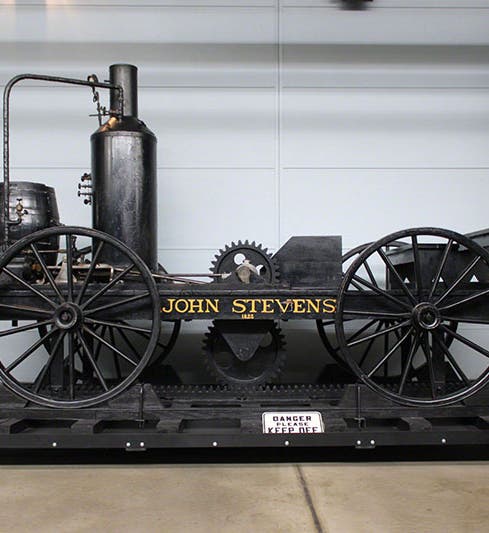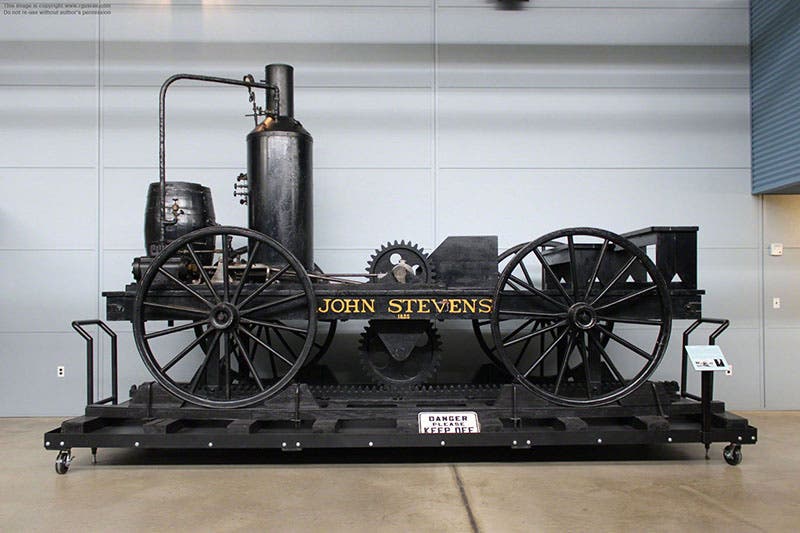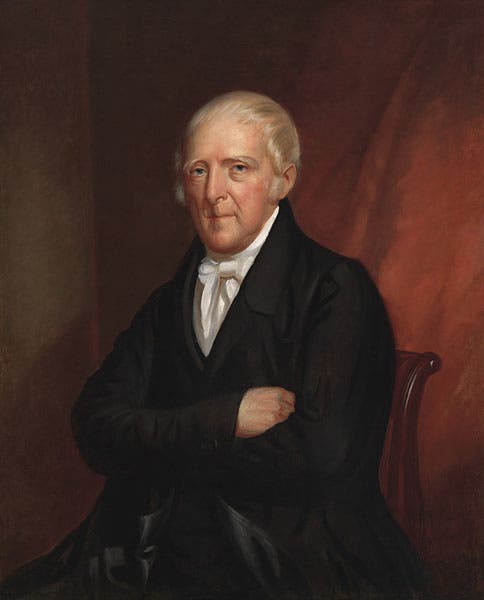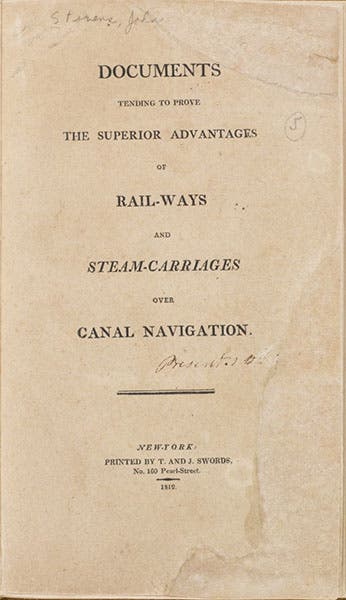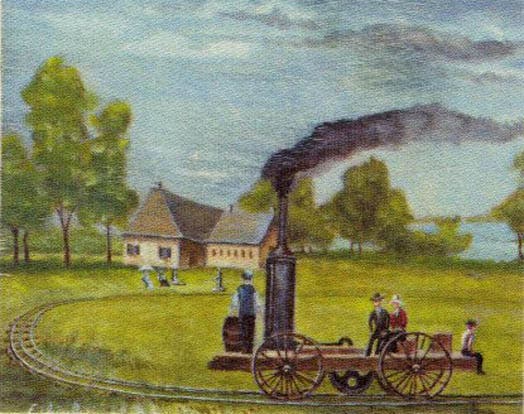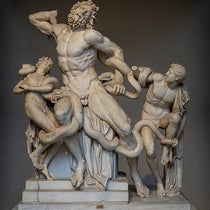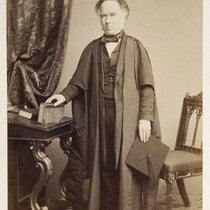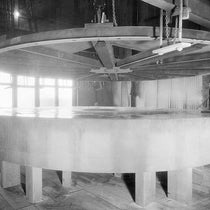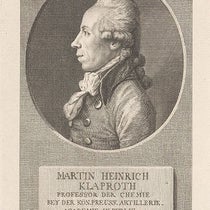Scientist of the Day - John Stevens
John Stevens III, an American inventor and public official, was born June 26, 1749, in New York City. He was perhaps the most inventive of the "Stevens family of inventors" that took up residence in Hoboken, New Jersey and helped that city rise to prominence.
During the early years of the Republic, Stevens served as Treasurer of the State of New Jersey, and he was instrumental in getting the Patent Office established in 1790. He then proceeded to build a steamboat in 1806, and then establish a public steam ferry service in 1809, intended to run from Hoboken to New York City, although it failed to attract investor interest and never became a going concern. No images survive that I have found of the steamboat (named Phoenix) or the ferry.
Stevens' real interest was in railways, of which there were none in the United States in 1812 (or anywhere else, for that matter), when Stevens published his first treatise proposing steam- powered railways as the preferred solution to our growing transportation problem. Nearly everyone else was looking towards canals as the solution, but Stevens argued that railways would be cheaper to build and operate, and would be faster as well. We do not have a copy of his original publication on the subject, Documents Tending to prove the Superior Advantages of Rail-ways and Steam Carriages Over Canal Navigation (1812, third image), but we do have a copy of the reprint that was published in 1852.
Stevens received various charters in New Jersey and New York to establish a railway, but he could not find financial backing. Finally, in 1825, he built his own locomotive (or steam carriage, as it is often called), and he built a circular railway on his estate at Castle Point in Hoboken, running his engine around his track at some 6 mph. In 1826, he allowed the public to ride his one-car train around his 200-foot circle. A painting (location unknown, fourth image) recorded the events of 1826. Suddenly, there was interest, and money, forthcoming.
John Stevens was now 75 years old and ready to hand the reins over to son Robert Livingston Stevens, who in 1830 became the first President of the country's first railway, the Camden and Amboy Railroad, based in Hoboken. For its first locomotive, they imported the John Bull from England, but almost immediately, Americans started building their own locomotives.
The steam carriage that John Stevens built in 1825 was our country's first home-built locomotive. That was and is a big deal. It does not survive, but enough drawings and paintings remain to have allowed replicas to be built. The first I know of was commissioned by the Stevens Institute of Technology (founded by another Stevens son and built on the Stevens estate at Castle Point), and built by the Pennsylvania Railroad in 1928. It is now on display at the Railroad Museum of Pennsylvania, near Strasburg (first image). A few years later, the PRR built a second replica for the “Century of Progress” exhibition in 1933-34. It went on display afterwards at the Museum of Science and Industry in Chicago for three-quarters of a century, and was then apparently deaccessioned and sold at auction in 2015. I have no idea where it is now.
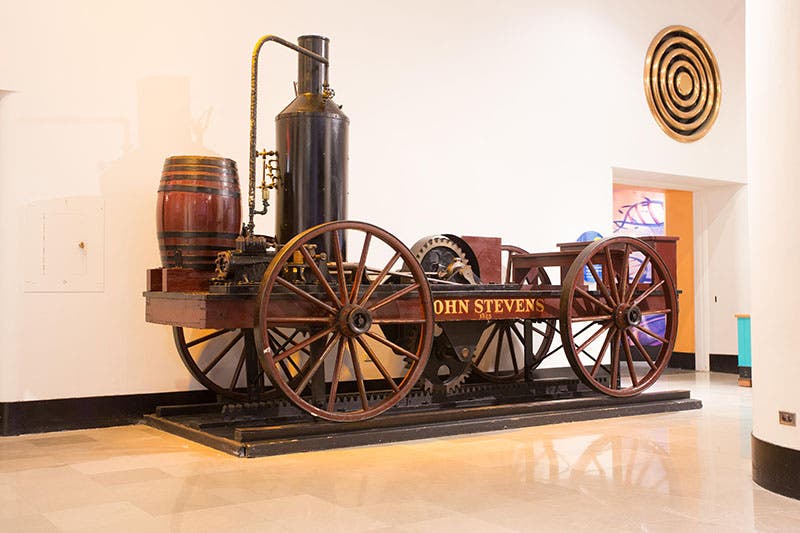
Another replica of the John Stevens locomotive of 1825, this one built by the Pennsylvania Railroad for the 1933-34 Century of Progress exhibition, put on display at the Museum of Science and Industry in Chicago, and then sold at auction in 2015, present whereabouts unknown. Please let me know if you know where it ended up.
When George Iles published his Leading American Inventors in 1912 (a copy of which we have in the library), he devoted the very first chapter to the Stevens family, especially John III, including a black-and-white reproduction of his portrait as a frontispiece. The original is in the National Portrait Gallery at the Smithsonian in Washington, D.C. (second image).
The Hoboken Museum in New Jersey not surprisingly has lots of John Stevens memorabilia. On one of their webpages, they reproduce in color a painting of the John Stevens locomotive of 1825, circling the track at the Stevens estate (fourth image). They don’t credit the painting, but since I have not seen a color reproduction elsewhere, perhaps they have the original. I thought at first it might be one of the 109 “Milestones in Transportation " paintings that Carl Rakeman did for the U.S. Department of Transportation in the 1920s and 30s, but it doesn't show up on their illustrated list.
John Stevens died on Mar. 6, 1838, at the age of 88. The location of his grave is unknown.
William B. Ashworth, Jr., Consultant for the History of Science, Linda Hall Library and Associate Professor emeritus, Department of History, University of Missouri-Kansas City. Comments or corrections are welcome; please direct to ashworthw@umkc.edu.

